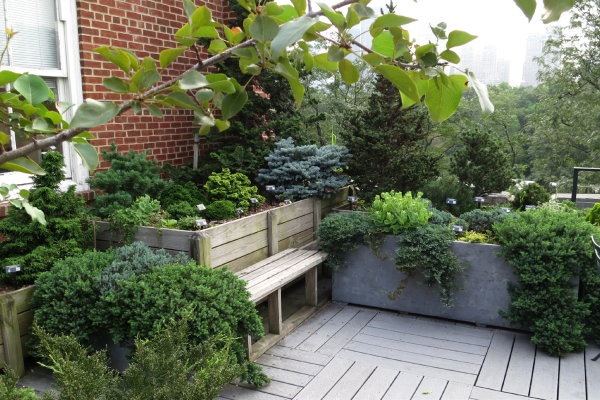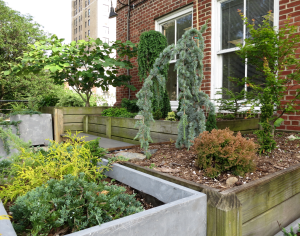In the fall of 2010, a small conifer test and display garden was installed atop the Arsenal in Central Park. Located on the East Side at Fifth Avenue and 64th Street, the building currently houses the headquarters offices of New York City's Department of Parks and Recreation and the Central Park Zoo. The garden has a north-facing exposure with the building protecting it on one side. Otherwise, the site is fairly exposed to the elements. The Arsenal rooftop is a challenging location since the garden is neither surrounded by buildings nor under a tree canopy. It is subject to very high winds. There is no irrigation system or formal maintenance program either. Instead, the garden is cared for with the help of interns and volunteers. More information about the garden and pictures of the original installation can be found in the Winter 2011 Conifer Quarterly, as well as in an article by Sean Callahan, Hidden Gem in the Making on the American Conifer Society website.
After the first year, we had a 75% survival rate. A couple of factors are likely to have been responsible for the loss of plants. Although a proponent of fall planting, logistics forced the initial planting into the first week in November, which may have been a bit late. This was followed by one of the worst winters on record. Perhaps if the plants had been more established fewer plants would have been knocked out. The good news is that during the later rounds, with winters delivering record cold and snow, only five plants were lost from the remaining original installation specimens that were replaced in year one.
The plants show an “all or nothing” pattern at the site. Besides those plants that had to be removed, only a couple of the remaining specimens looked a bit worse for wear after the challenging first winter. Most looked perfect and were pushing new growth. I have noticed a trend with conifers here in Manhattan; year one appears to be the year that makes all the difference. Even in less severe conditions, with proper irrigation, year one poses a challenge, and the plants are either lush and vibrant and off to the races, or completely dead.
Perhaps not surprisingly, our expectations as to which plants would do well did not play out. From the beginning, we recognized the site as being tough: no irrigation, a light-weight soil medium with little organic matter (Gaia soil, a peat-based potting mix), high winds, urban pollutants, and the urban heat island effect.
We thought plants like Pinus heldreichii ‘Irish Bell’ and the various junipers would be as tough as nails, and the cedrus more delicate, but we were incorrect. One might be inclined, since this was in a single test garden with limited specimens, to call this a fluke, but at another site in Manhattan I work on that features a number of conifers, Pinus heldreichii and any number of junipers also did not survive. It may be that these plants have difficulty in the City because they are grown in container gardens. However, interestingly, my father also had some difficulty with the Juniperus horizontalis ‘Icee Blue’ in the ground on Long Island, as it appears fussy until well established. Only one of two Juniperus horizontalis ‘Icee Blue’ planted at the Arsenal survives, again illustrating the importance of care until the plants are acclimated and established.
Although, in general, dwarf and miniature varieties of plants seem to be more robust, on urban rooftops, the larger juniper specimens have done well, while our dwarf favorites seem to be hit or miss. Plants like Juniperus procumbens ‘Nana’, J. squamata ‘Blue Star’, as well as the ‘Icee Blue’ mentioned above have turned out to be not well suited to rooftop environments. Junipers in general, though, may not be the right choice for rooftops for completely different reasons. On the terraces and balconies in the City, clients and their plants live in close proximity to each other. Working with junipers and installing them can give us gardeners the “juniper itch,” and, although clients may not be as close to their plants as we gardeners are, the people who own these gardens may like to brush their hands along their plants, walk barefoot outdoors, and may even be allergic.
In the City, wind and the resulting desiccation are also factors to contend with. Many times we think of this as a winter phenomenon as it is especially a concern in containers that freeze solid during the winter. Interestingly, this has not been the case for conifers here in the City, either for the dwarf plants discussed here, or larger specimens that can be used as hedging plants – Juniperus chinensis ‘Hetzii Columnaris’, Juniperus virginiana 'Emerald Sentinel', and various thuja, for example. Even with proper irrigation, it appears that desiccation is a summer event in the City, and when compounded with the hot buildings and HVAC venting atop many of these roofs and terraces, there is no room for error. The lack of irrigation at the Arsenal makes it a true test garden in the summer months.
Although I will not list every plant at the Arsenal, a number of chamaecyparis that were already at the site, as well as the Chamaecyparis obtusa ‘Nana Lutea’ and ‘Lynn's Golden’ that were planted in the fall of 2011, have done very well. There is an odd trend, where the fairly globose, or somewhat pyramidal forms, have not retained their shape, but have grown horizontally and irregularly, even though neither lack of sunlight or crowding are issues at the site.
Two cedars, Cedrus deodara ‘Prostrate Beauty’ and C. deodara ‘Blue Ball’, did well for five years, and then, after pushing spring growth, both completely defoliated in a matter of a week. Since they survived for so long and have performed admirably at this site and others, I will call this an aberration. We are trying two more cedrus at the site that seem to be very content. Cedars fall into the surprise category, as we thought they would be more delicate and I had never seen them used on rooftops before. The other conifers introduced into the garden were a very small Picea abies ‘Gem’ (since deceased), Abies balsamea ‘Piccolo’, and Tsuga canadensis ‘Minuta’. Since these are single plants any observations are of limited value. However, I was surprised by the success of the abies considering the lack of irrigation and the humid weather. I am pleased to see tsuga surviving as it may also be a good choice for shadier sites, and as we are expanding the garden this year into a new corner where shade plays more of a role. These are in addition to Cryptomeria japonica ‘Tansu’, which has excelled. Caution to those who wish to use cryptomeria on rooftops. They need to be protected from direct sun and dessicating winds, especially in the winter. The specimen on the Arsenal rooftop sits low to the ground, and is nestled against the building. It needs a good number of hours of sunlight to thrive and remain full, thus making siting critical for growth. Various dwarf Picea abies cultivars have shown mixed results for us.
Any number of pine species and cultivars seem to excel on rooftops, including but not limited to Pinus thunbergii ‘Thunderhead’, P. densiflora ‘Low Glow’, P. sylvestris ‘Hillside Creeper’, P. banksiana ‘Schoodic’, and P. mugo ‘Mughus’. Interestingly, pines appear to take sun and drought better than many of the other conifers, but suffer the most from winter desiccation, unlike the other conifers for which summer desiccation is more of a threat.
We have also added some non-conifer specimens, with a focus on dwarf plants such as Ilex crenata ‘Dwarf Pagoda’, Rhodendron keiskei ‘Fairy's Fairy’, and Acer palmatum ‘Winter Flame’. These plants add different textures and further blend the Conifer Corner with the rest of the garden. As an aside, Japanese maples do remarkably well on rooftops and are a lot less delicate than they may first appear – I would dare say they are our best performing specimen container trees in the City.
Overall, at the test garden at the Arsenal, and other sites in the City, dwarf conifers do very well in containers due to their size, slow growth rate, evergreen foliage, and diversity of form, texture, and color. I find that conifers can make for a very clean, almost sterile and regimented design. Many people want a fairly dense planting and inter-planting with non-conifer species to create a visually pleasing garden. Unlike in a suburban garden, where your plantings are surrounded by lawn, trees, or beds, in the City, plants are in containers, and surrounded by walls, railings, pergolas, and the building itself, all very constructed environments.
In just the few years, the scale of the Arsenal test garden is already feeling mature, with plants beginning to “kiss” each other. As always, the challenge is to find a balance, because on the rooftop, like many rooftops in the City, there is simply limited space into which to transplant the existing specimens or add more plantings and containers. Perhaps this is why annuals and tropicals are so popular on rooftops. You start with a blank canvas year after year. Yet conifers, which are underutilized on urban rooftops, and are too often relegated to hedging material, are in many ways ideal for these spaces. Many people want the feeling of being surrounded by trees on their rooftops, and often large mature trees are not possible. Much like bonsai, conifers can offer the shape, feeling, and structure of a large tree without being all that large. Not only are small specimen conifers ideal for small containers, but even large specimens, 6-12 feet (1.8-3.6m), do very well in small containers. We have plenty of six-foot (1.8 m) plants in 18- or 24-inch (45 or 60 cm) containers that, although not necessarily ideal, do well and meet the challenges we face in the City with limited space. Acer aside, I can’t say that I have seen another group of trees or large shrubs that do as well in small containers.
Overall, maybe there is no one knockout plant, but chamaecyapris cultivars are my rooftop favorite and do very well. They offer so many different sizes, colors, and a very unique texture, especially for those who find conifers too rigid or formal.
Another example of the possible uses of conifers in the City is a garden I work on professionally. This garden, one of the highest residential garden spaces in New York City, is also composed mostly of conifers and has helped inform some of my observations in this article. That far up is like planting on the side of a mountain, and when you are not in the clouds, you have views of Central Park, the Hudson River, and New Jersey to the west, and the East River and Queens to the east. This site only receives maintenance a few times a year and conifers are one of the few groups of plants that can face the challenges of the site while also adding four season interest for the owners of the apartment.
Rooftop Conifer Garden

September 26, 2020
IN ANY GREAT pugilistic match, the first few rounds are a feeling out process. You have to learn the strengths and weaknesses of your opponent, adapt, and prepare for surprises. Like a boxing match, the conifer test and display garden atop the Arsenal in New York City, which was my first experience with conifers on rooftops, took a few rounds to feel out, but now it is, I believe, a knockout.
(This article was previously published in Conifer Quarterly, the journal of the American Conifer Society.)

